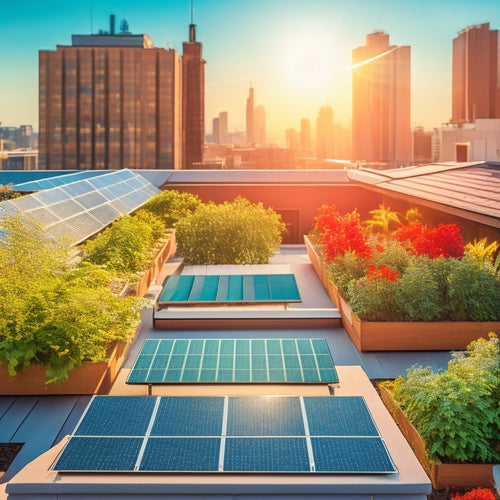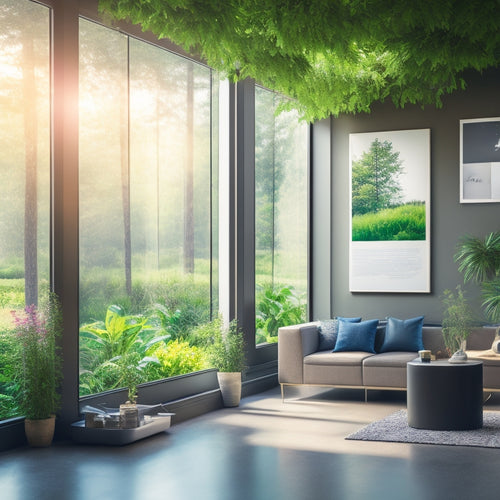
What Are the 3 Essential Costs to Set Up Solar Panels
Share
When setting up solar panels, you'll need to evaluate three essential cost categories. First, equipment and material expenses include the solar panels, inverters, energy storage systems, and mounting hardware, which can vary depending on the type and quality of the components. Second, installation and labor costs depend on factors like roof size and complexity, solar panel type, and local labor rates. Finally, permitting and inspection fees, which include required permits and multiple inspections, can range from $500 to $2,000 or more. Understanding these costs will give you a thorough overview of what to expect - and there's more to investigate.
Key Takeaways
- The three essential costs to set up solar panels are equipment and material costs, installation and labor costs, and permitting and inspection fees.
- Equipment and material costs vary depending on the type and quality of solar panels, inverters, and energy storage systems.
- Installation and labor costs are influenced by roof size and complexity, solar panel type, and local labor rates.
- Permitting and inspection fees range from $500 to $2,000 or more, depending on system complexity and local regulations.
- It's crucial to consider all three essential costs when budgeting for solar panel installation to ensure a comprehensive and accurate estimate.
Equipment and Material Costs
Most solar panel installations require several key components, which come at a cost. You'll need to invest in solar panels themselves, which can vary in price depending on the type and quality. Monocrystalline solar panels, for instance, are more expensive than polycrystalline ones. The number of panels you need will also impact the overall cost, as you'll require more panels to generate more power.
In addition to the solar panels, you'll need an inverter to convert DC power into AC power that's usable in your home. The type of inverter you choose can also affect the cost, with string inverters being more affordable than microinverters.
Energy storage systems, such as batteries, are also essential if you want to store excess energy generated during the day for use at night or during power outages. The cost of energy storage can vary widely depending on the type and capacity of the system.
Additionally, you'll need mounting hardware, wiring, and other accessories to complete the installation. These components may seem like small expenses, but they add up quickly.
Installation and Labor Costs
Once you've selected your equipment and materials, it's time to contemplate the costs associated with physically installing your solar panel system. This is where the skill of a professional installation team comes in.
The installation process involves several complex tasks that require specialized abilities and equipment.
Here are some key factors that influence installation and labor costs:
- Roof size and complexity: Larger roofs with multiple angles or obstructions require more labor and equipment, increasing costs.
- Solar panel types: Thin-film panels are generally easier to install than crystalline silicon panels, affecting labor costs.
- Installation techniques: Mounting systems, such as tracking systems or tilt legs, can add complexity and cost to the installation process.
- Local labor rates: Installation companies in urban areas tend to charge more than those in rural areas due to higher labor costs.
When evaluating installation and labor costs, consider the skill and reputation of the installation company, as well as any warranties or guarantees they offer.
A reputable installer will guarantee a safe, efficient, and high-quality installation that meets local building codes and regulations.
Permitting and Inspection Fees
Several permits and inspections are required before, during, and after the installation of your solar panel system, and these regulatory obstacles come with associated fees.
You'll need to obtain permits from your local government, which can include electrical, building, and zoning permits. These permits guarantee your solar panel system meets local regulatory requirements and safety standards.
The permitting process typically involves submitting plans and designs for your solar panel system, which will be reviewed by local authorities. You may need to pay for multiple inspections, including a pre-installation inspection to verify your system's design, and a final inspection to confirm the system is installed correctly.
Inspection timelines can vary, but you can expect the process to take several weeks to a few months.
The costs of permitting and inspection fees vary by location, but you can expect to pay anywhere from $500 to $2,000 or more, depending on the complexity of your system and local regulations.
It's crucial to factor these costs into your overall budget to guarantee you have a clear understanding of the total cost of installing your solar panel system.
Frequently Asked Questions
Can I Install Solar Panels on a Rented Property?
You'll need to contemplate rented property considerations, like getting your landlord's permission, before installing solar panels, as you'll be making changes to their property; make certain you obtain necessary solar panel permissions to avoid any legal or financial issues.
Do Solar Panels Work During Power Outages?
You're a million times more likely to stay powered during an outage with solar panels, but only if you've got grid independence and energy storage in place, allowing you to capture the sun's energy even when the grid goes dark.
Are Solar Panels Resistant to Extreme Weather?
You'll be relieved to know that solar panels are designed to withstand extreme weather conditions, boasting impressive durability and resilience. They're built to resist heavy snow, hail, and high winds, ensuring your power supply remains uninterrupted.
Can I Sell Excess Energy Back to the Grid?
Like a modern-day Robin Hood, you'll be giving back to the grid with net metering benefits, tracking your energy consumption to sell excess back and offsetting your bills, making you the ruler of your energy domain.
Do Solar Panels Require Regular Maintenance?
You'll need to perform regular solar panel cleaning and maintenance to guarantee peak energy production, typically every 6-12 months, depending on your location and climate, to remove dirt and debris that can reduce efficiency.
Conclusion
Setting up solar panels is like steering a three-legged stool - each vital cost is imperative for stability. You've got to take into account the trio: equipment and material costs, installation and labor costs, and permitting and inspection fees. Without one, the whole system comes crashing down. By understanding these three pillars, you'll be well on your way to utilizing the sun's energy like a pro, with a setup that's as solid as a rock.
Related Posts
-

Solar System Installation Rebates and Tax Credits
Solar system installations offer beneficial rebates and tax credits that greatly cut your initial costs. You can bene...
-

Integrating Smart Technology for Energy Savings
Integrating smart technology into your home is a transformative factor for energy savings. Smart thermostats give you...
-

High-Performance Energy-Efficient HVAC Systems
High-performance energy-efficient HVAC systems are essential for reducing energy consumption while improving indoor c...


